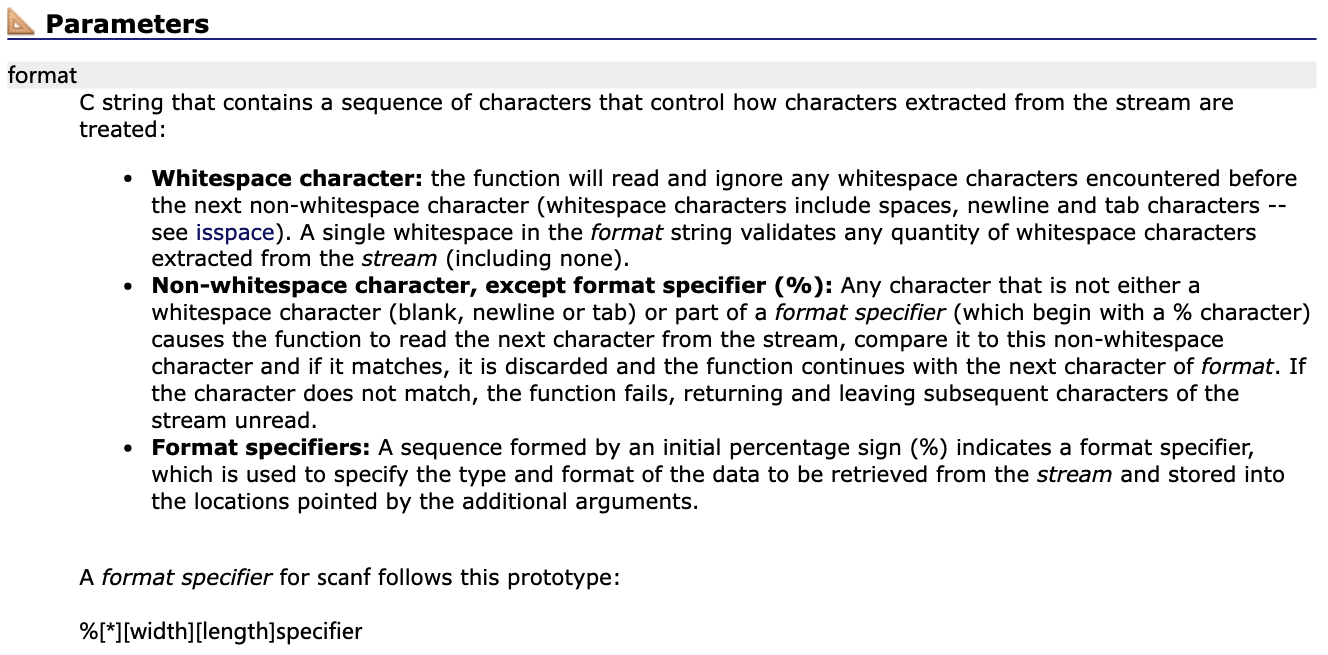cin cout
#include <iostream>using namespace std;int main(){int x;cin >> x;cout << x;return 0;}
printf
#include <cstdio>using namespace std;int main(){int x;scanf("%d", &x);printf("%d\n", x);printf("%10d\n", x); // 占10个字符宽度,靠右对齐printf("%-10d\n", x); // 占10个字符宽度,靠左对齐double y;scanf("%lf", &y);printf("%lf\n", y);printf("%.2lf\n", y); //小数点后保留2位return 0;}
// 如果输出是两个int,中间有一个空格int a = 1, b = 2;printf("%d %d", a, b);// 如果输出是两个int,中间有一个加号int a = 1, b = 2;printf("%d+%d", a, b);// 如果只是输出一句话,可以这样printf("Hello world\n");// 在双引号里面,是所见即所得// %d 称之为,format specifier, 格式化符号// % 后面跟什么,是不同变量类型,跟不同的东西// 常见的,%d int,%lf double,%c 字符,%s 字符串

#include <iostream>#include <cstdio>using namespace std;int main(){char c;//cin >> c;//cout << c << '\n';// a b c A B C * - 1 0scanf("%c", &c);printf("%c\n", c);return 0;}
// 学习一下字符数组、一维字符数组、二维字符数组// string类#include <bits/stdc++.h>using namespace std;char c;string s1;char s2[110];char s3[110][110];int main(){// 以字符为例cin >> c;cout << c << '\n';// 读入string类cin >> s1;cout << s1 << '\n';// 读入字符数组scanf("%s", s2);printf("%s\n", s2);// 读入二维字符数组int n;cin >> n;for (int i = 0; i < n; i++) scanf("%s", s3[i]);for (int i = 0; i < n; i++) printf("%s\n", s3[i]);return 0;}
// 占用字符宽度// int类型 占多少个字符宽度cin >> n;printf("%8d %8d\n", n, n);printf("%-8d %-8d\n", n, n);
// 保留小数点的问题// double 类型保留小数点后几位printf("%.20lf\n", 1.0 / 3);// 一般就用printf解决保留小数点几位的问题,不用setprecision,主要是记不住// 竞赛当中,很少使用不用setprecisiondouble x = 3.1415926;cout << x << '\n';cout << setprecision(5) << x << '\n';cout << setprecision(4) << x << '\n';cout << setprecision(3) << x << '\n';cout << setprecision(2) << x << '\n'; // 3.1cout << setprecision(1) << x << '\n'; // 3// setprecision 不计算小数点// #include <iomanip>// 与 setw 字段宽度不同的是// setprecision 的精度设置将保持有效,直到更改为其他值为止// 流操作符 setw 可用于建立指定宽度的打印区域// 空格“填充”在前面,所以它被认为是右对齐的// 左对齐也能搞,麻烦// 用一回,写一回int y;cin >> y;cout << setw(8) << y << setw(8) << y << '\n';
scanf

注意看,这个参数是 point to already allocated objects,指向了一个已经存在的对象
#include <bits/stdc++.h>using namespace std;int main(){int x;scanf("%d", &x); // &取地址符号printf("%d\n", x);return 0;}/*输入:123输出:123*/#include <bits/stdc++.h>using namespace std;int main(){int x;scanf("%d", x);printf("%d\n", x);return 0;}// 编译报错std03.cpp:7:14: warning: format specifies type 'int *' but the argument has type 'int'[-Wformat]scanf("%d", x);~~ ^
#include <bits/stdc++.h>using namespace std;int main(){int x;int *px = &x;scanf("%d", px);printf("%d\n", x);return 0;}/*输入:123输出:123*/#include <bits/stdc++.h>using namespace std;int main(){int x;int *px = &x;scanf("%d", *px); //如果这样写printf("%d\n", x);return 0;}//编译报错std03.cpp:8:14: warning: format specifies type 'int *' but the argument has type 'int'[-Wformat]scanf("%d", *px);
#include <bits/stdc++.h>using namespace std;int a[10];int main(){for (int i = 0; i < 5; i++)scanf("%d", a + i);//scanf("%d", &a[i]); //这两句话作用是一样的return 0;}
//读入字符串#include <bits/stdc++.h>using namespace std;char s[10];int main(){scanf("%s", s); //这个时候,写的是数组名称,数组名本身就是一个指针return 0;}
// 在读入数据的时候,充分利用格式化的优点// 输入数据1980-12-1#include <bits/stdc++.h>using namespace std;int year, month, day;int main(){scanf("%d-%d-%d", &year, &month, &day);printf("%d %d %d\n", year, month, day);return 0;}

// 上图,解释了,scanf里面有空格不影响的原因// 还有scanf里面有具体符号时候,匹配的问题// 还有具体限制读入一个字符宽度的数字#include<bits/stdc++.h>using namespace std;int main(){int a, b, c;scanf("%1d%1d%1d", &a, &b, &c);printf("%d %d %d\n", a, b, c);return 0;}/*123*/
例题,1982:【19CSPJ普及组】数字游戏
// 这个就可以利用scanf的性质处理
例题,计算三角形面积
//海伦公式p = (a+b+c) / 2;s = sqrt(p * (p-a) * (p-b) * (p-c));#include<iostream>#include<cstdio>#include<cmath>using namespace std;int main(){double x1, y1, x2, y2, x3, y3, a, b, c, p, s;scanf("%lf%lf%lf%lf%lf%lf",&x1,&y1,&x2,&y2,&x3,&y3);a = sqrt((y2-y1)*(y2-y1)+(x2-x1)*(x2-x1));b = sqrt((y3-y1)*(y3-y1)+(x3-x1)*(x3-x1));c = sqrt((y2-y3)*(y2-y3)+(x2-x3)*(x2-x3));p = (a+b+c)/2;s = sqrt(p*(p-a)*(p-b)*(p-c));printf("%.2lf",s);return 0;}
例题,等差数列末项计算
//等差数列求和公式#include <bits/stdc++.h>using namespace std;int main(){int a1, a2, n;cin >> a1 >> a2 >> n;int d = a2 - a1;int an = a1 + (n - 1) * d;cout << an << endl;return 0;}
例题,计算2的幂
//幂次,方 的叫法#include <bits/stdc++.h>using namespace std;int main(){int n;cin >> n;int res = 1;while (n--){res *= 2;}cout << res << endl;return 0;}
例题,苹果和虫子
//还是题意,剩余多少完整的苹果//也要注意苹果很少,时间很长的情况,会是什么结果【*】
整数除法
int x = 1, y = 2;cout << x / y << '\n';// 会输出 0// 整数除以整数,会自动向下取整cout << (x + y - 1) / y << '\n';// 这样做会得到一个向上取整的结果double z = 1.0 * x / y;// 这样能得到一个小数结果

